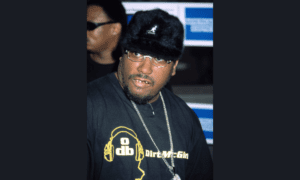
15 Classic Hip-Hop Albums | March Edition
Hip-hop and R&B have produced some of the most iconic albums of all time, and March has been a significant month for the best classic hip-hop albums. From boundary-pushing debuts to genre-defining works, here are some of the most notable hip-hop and R&B albums released in March:
__________________________________________________________________________________
15.
Busta Rhymes – The Coming
Busta Rhymes’ debut solo album “The Coming” was a commercial and critical success. The album features Busta’s trademark energetic delivery and a range of production styles, from the hard-hitting “Woo Hah!! Got You All in Check” to the more introspective “Everything Remains Raw.”
Related: Experience the evolution of rap with our guide to the Best Hip-Hop Albums of All Time.
__________________________________________________________________________________
14.
Gang Starr – Hard to Earn
“Hard to Earn,” released on March 8, 1994, is the fourth studio album by Gang Starr. The album features classic tracks like “Mass Appeal” and “DWYCK” and showcases Guru’s lyrical prowess and Premier’s hard-hitting production. “Hard to Earn” is a landmark album in the history of hip-hop and helped to solidify Gang Starr’s status as one of the greatest duos in the genre.
__________________________________________________________________________________
13.
M.I.A. – Arular (March 22, 2005)
M.I.A.’s debut album “Arular” introduced the world to her unique blend of global beats, political commentary, and bold fashion sense. The album features the hit singles “Galang” and “Sunshowers.” It is a testament to M.I.A.’s pioneering spirit and boundary-pushing creativity.
__________________________________________________________________________________
12.
E-40 – The Block Brochure: Welcome to the Soil 1, 2, 3
“The Block Brochure: Welcome to the Soil 1, 2, 3” is a triple album by the Hypy rapper released on March 26, 2012. The album features a whopping 60 tracks and showcases E-40’s unique flow and lyrical prowess. The album is a testament to E-40’s longevity in the rap game and his ability to remain relevant and innovative throughout his career.
__________________________________________________________________________________
11.
People Under the Stairs – The Next Step
The Next Step is the third studio album by underground hip-hop duo People Under the Stairs. The album features the group’s signature blend of jazz and funk-influenced beats. In addition, it showcases their laid-back flow and witty lyricism. “The Next Step” is a must-listen for underground hip-hop fans and a testament to People Under the Stairs’ influence on the genre.
__________________________________________________________________________________
10.
Gang Starr – Moment of Truth
Released on March 31, 1998, Moment of Truth is the fifth studio album by legendary hip-hop duo Gang Starr. The album features classic tracks like “You Know My Steez” and “The Militia,” and showcases Guru’s smooth flow and Premier’s innovative production. “Moment of Truth” is a testament to Gang Starr’s influence on hip-hop and their lasting legacy.
__________________________________________________________________________________
9.
Run-D.M.C. – Run-D.M.C.
Run-D.M.C., released on March 27, 1984, is the self-titled debut album by hip-hop pioneers Run-D.M.C. The album features the group’s signature blend of rock and hip-hop and includes classic tracks like “It’s Like That” and “Sucker M.C.’s.” “Run-D.M.C.” is a groundbreaking album that helped to popularize hip-hop and bring it to a broader audience. This release is clearly one of the best old-school albums.
__________________________________________________________________________________
8.
Big L – Lifestylez ov da Poor & Dangerous
Lifestylez ov da Poor & Dangerous is the debut album by rapper Big L. The album features classic tracks like “Put It On” and “MVP,” and showcases Big L’s intricate wordplay and vivid storytelling. “Lifestylez ov da Poor & Dangerous” is a testament to Big L’s talent and potential, which were tragically cut short when he was murdered in 1999.
Lifestylez ov da Poor & Dangerous was the debut studio album by Harlem rapper Big L and is widely regarded as a genre classic. The album is characterized by Big L’s intricate wordplay and complex rhyme schemes, demonstrating his incredible skill as a lyricist.
Big L’s lyrics drew from his personal experiences growing up in the tough streets of Harlem. In “Street Struck,” he raps about the dangers of life in the ghetto and the pressures young men face to turn to crime to survive. In “No Endz, No Skinz,” he tells a story about a woman he meets who turns out to be a prostitute, reflecting on the harsh realities of the sex trade and its impact on those involved.
Despite its often dark subject matter, Lifestylez ov da Poor & Dangerous also features moments of humor and lightheartedness. For example, in “M.V.P.,” Big L boasts about his skills as a rapper, declaring himself the “most valuable poet on the M-I-C.” And in “All Black,” he shows off his wit and wordplay, rapping about his love of designer clothes and his disdain for those who can’t afford them.
Tragically, Big L’s promising career was cut short when he was shot and killed in Harlem in 1999 at just 24. However, his influence on the hip-hop genre can still be felt today, and “Lifestylez ov da Poor & Dangerous” is a testament to his incredible talent and impact on the genre.
__________________________________________________________________________________
7.
Ginuwine – 100% Ginuwine
100% Ginuwine is the second studio album by R&B singer Ginuwine. The album features classic tracks like “So Anxious” and “Same Ol’ G” and showcases Ginuwine’s smooth vocals and romantic lyrics. “100% Ginuwine” is a testament to the R&B music of the late 90s and helped to establish Ginuwine as one of the leading voices in the genre.
Timbaland played a significant role in producing 100% Ginuwine, serving as the album’s executive producer and contributing to the beats on several tracks. The album was made during the peak of Timbaland’s career. His signature style of innovative beat-making, incorporating a wide range of samples and unconventional sounds, can be heard throughout the album. His production on the album is characterized by his use of intricate drum patterns, hypnotic synth melodies, and quirky vocal samples, creating a unique sound that would continue to influence R&B and hip-hop production for years to come.
One of the standout tracks on the album is “Same Ol’ G,” which was produced by Timbaland and featured his signature style of off-kilter beats and unconventional sounds. The track features a catchy hook and a smooth, laid-back flow from Ginuwine, making it an instant classic. “Same Ol’ G” was a commercial success, reaching number 25 on the Billboard Hot 100 chart and solidifying Ginuwine’s reputation as a leading voice in R&B music.
__________________________________________________________________________________
6.
Common – Like Water for Chocolate
Like Water for Chocolate is a seminal album in the career of Common. The album features production from the legendary J Dilla. It showcases Common’s introspective lyrics and socially conscious themes, making it one of the most impactful and essential hip-hop albums of the early 2000s. Commons Be is featured in our list of classic albums released in May.
__________________________________________________________________________________
5.
Ghostface Killah – Fishscale
Fishscale, released on March 28, 2006, is Ghostface Killah’s fifth studio album and is widely regarded as one of his best works. The late-career renaissance features gritty production, intricate storytelling, and a range of guest appearances from Raekwon, Method Man, and Ne-Yo. “Fishscale” is a masterclass in storytelling and cemented Ghostface’s status as one of hip-hop’s greatest storytellers.
The beats for Fishscale were primarily produced by notable hip-hop producers, including MF DOOM, Just Blaze, and Pete Rock. MF DOOM made six tracks on the album, including the opening track “The Return of Clyde Smith (Skit)” and the lead single “Back Like That.” Just Blaze produced two tracks, “The Champ” and “Underwater,” while Pete Rock produced one beat, “Jellyfish.” In addition to these producers, the album also features beats from other notable producers, such as J Dilla and Madlib.
The production of Fishscale is widely praised for its return to the classic Wu-Tang sound, which complements Ghostface Killah’s vivid storytelling and complex lyricism. The beats range from hard-hitting boom-bap to smooth, jazzy instrumentals and showcase the diverse influences that have shaped Ghostface Killah’s sound over the years.
Behind the ‘W’ Logo: Discover the stories and contributions of each Wu-Tang Clan member, including Ghostface.
J Dilla, also known as Jay Dee, was one of the most influential hip-hop producers of all time, known for his innovative use of sampling and his soulful, jazz-infused beats. He contributed to the production of “Fishscale” with his work on the tracks “Whip You With a Strap,” “Beauty Jackson,” and “9 Milli Bros.” His production on these tracks is characterized by his signature style of chopped-up samples, syncopated drums, and soulful melodies.
J Dilla’s contributions to Fishscale are a testament to his enduring influence on the sound of hip-hop. His beats are widely praised for their emotional depth and musical complexity and continue to inspire new generations of producers and artists. Incorporating J Dilla’s production on Fishscale helped solidify Ghostface Killah’s reputation as a lyricist with an ear for excellent beats. The album stands as a testament to the enduring legacy of both artists.
__________________________________________________________________________________
4.
De La Soul – 3 Feet and Rising
De La Soul’s debut album 3 Feet and Rising was a game-changer for hip-hop. The album’s innovative production sampled from diverse sources, including early-to-the-hip-hop game jazz aesthetics.
Released in 1989, this groundbreaking album helped redefine hip-hop’s sound. At a time when mainstream rap was dominated by hard-edged beats and aggressive lyrics, De La Soul’s music stood out for its playful, light-hearted approach and psychedelic production. Other classic De La Soul albums include The Stakes is High and Buhloone Mindstate.
One of the most notable features of the album was its heavy sampling from a wide range of musical genres, including funk, soul, and rock. This eclectic approach to musical appropriation departed from the more traditional approach to hip-hop production at that point. As a result, it helped pave the way for the rise of hip-hop’s “golden age” in the early 1990s.
In addition to its innovative production, “3 Feet and Rising” displayed more positive, uplifting lyrics, standing in stark contrast to the gangsta rap popular then. De La Soul’s music celebrated creativity, individuality, and community. It helped to promote a more positive image of hip-hop culture. Learn more about the legendary trio in Mass Appeal’s documentary chronicling the group. Check out our list of best De La Soul songs!
__________________________________________________________________________________
3.
Ol’ Dirty Bastard – Return to the 36 Chambers: The Dirty Version
Ol’ Dirty Bastard was a larger-than-life personality known for his unpredictable behavior on and off stage. He often jumped on stage uninvited during other artists’ performances and gave impromptu speeches at industry events. “Wu-Tang is for the children” will live on forever.
Despite his controversial moments, outrageous antics and irreverent humor endeared him to fans and fellow artists. Widely respected as a hip-hop pioneer, ODB’s influence can be heard in hip-hop still.
His debut album, “Return to the 36 Chambers: The Dirty Version,” released on March 28, 1995, was critically acclaimed and commercially successful. The album’s gritty, off-kilter production and ODB’s unpredictable rhymes revealed a new, charismatic personality.
As a member of The Wu-Tang Clan, Ol’ Dirty Bastard was one of the standout members, alongside the group’s de facto leader, RZA. RZA made the beats for the group member’s early albums, including Ol’ Dirty Bastard’s debut. He utilized samples from kung-fu movies, soul records, and other obscure sources to create a gritty and atmospheric sound that perfectly complemented ODB’s unique rhyming style. RZA’s contributions established the group as one of hip-hop’s most enduring legacies.
__________________________________________________________________________________
2.
Notorious B.I.G. – Life After Death
“Life After Death” is the second and final studio album by the Notorious B.I.G. The album features a range of styles, from the hardcore East Coast sound of “Hypnotize” to the smooth R&B of “Mo Money Mo Problems.” The album succeeded commercially, solidifying Biggie as one of the greatest rappers ever.
“Life After Death” was released weeks after Biggie Smalls was tragically murdered in a drive-by shooting in Los Angeles.
The album’s lyrics shed light on Biggie’s life growing up in Brooklyn and his rise to fame as a rapper. For example, in “Somebody’s Gotta Die,” Biggie raps about a violent altercation he witnessed as a child. Also, in “My Downfall,” he reflects on his struggles with the law and the pressures of the music industry.
Other tracks, such as “Niggas Bleed” and “I Got a Story to Tell,” weave cinematic tales of drug deals gone wrong and steamy affairs with married women, respectively. “I Got a Story to Tell” also includes one of our favorite Utah Jazz references in hip-hop. “I Including an affair with a wife of a former New York Knick.
Despite its often dark subject matter, “Life After Death” is notable for its playful humor and irreverent spirit. Songs like “Notorious Thugs” and “Hypnotize” feature infectious hooks and clever wordplay, showcasing Biggie’s talent for crafting catchy anthems.
__________________________________________________________________________________
1.
Madvillain – Madvillainy
“Madvillainy” is a collaborative album by rapper MF DOOM and producer Madlib. The album features Madlib’s eclectic and off-kilter beats and DOOM’s intricate and dense rhymes, making it a landmark in underground hip-hop.
The creation of “Madvillainy” was a unique collaborative effort between MF DOOM and Madlib. The two exchanged music back and forth as they worked on the album. According to MF DOOM, the collaboration began when Madlib sent him a beat tape with over 40 instrumentals. MF DOOM immediately began writing rhymes over the beats. The two artists then started sending tracks back and forth, with Madlib sending DOOM beats and DOOM sending back finished verses and songs.
This collaborative process allowed the two artists to work independently and experiment with different sounds and ideas. As a result, Madlib’s production on the album includes obscure samples and unconventional drum patterns. At the same time, MF DOOM’s rhymes are dense and intricate, full of complex wordplay and vivid imagery. The resulting album is a masterpiece of experimental hip-hop, with its unique blend of abstract beats and complex lyricism.
Madlib and MF DOOM’s collaborative album “Madvillainy” is often cited as a pioneering work in the lo-fi hip-hop genre, emphasizing low-fidelity or “imperfect” sound quality as a stylistic choice. The lo-fi aesthetic has become increasingly popular in recent years, with countless artists drawing inspiration from Madlib and MF DOOM’s work on “Madvillainy.”
One of the defining characteristics of the lo-fi sound is the use of samples and field recordings that are deliberately distorted or degraded, often to create a vintage or nostalgic feel. The production on “Madvillainy” incorporates these elements heavily, with Madlib often sampling obscure jazz and funk records, distorting them heavily to create a gritty, rough-edged sound. MF DOOM’s rhymes, meanwhile, often use unconventional flows and obscure references, adding to the album’s peculiar feel.
The influence of “Madvillainy” on the lo-fi beat aesthetic can be seen in the work of countless producers and artists who have incorporated similar elements into their own music. This album truly represents what makes a classic hip-hop album. Sadly, MF DOOM passed away in 2020.
__________________________________________________________________________________
March has released some of the most influential and groundbreaking hip-hop and R&B albums ever. From the pioneering sounds of Run-D.M.C. to the introspective lyricism of Gang Starr, these albums have helped to shape and define the genres and continue to inspire and influence new generations of artists.
Check out classic albums that came out in April and May.









